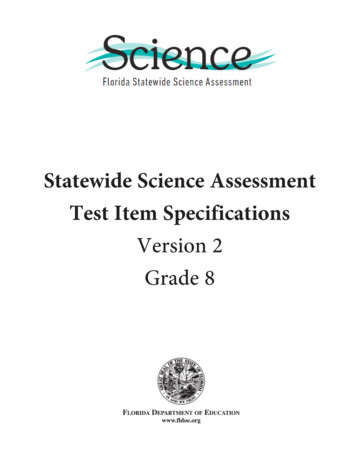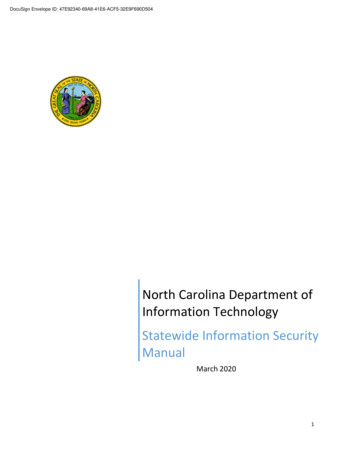
Transcription
Statewide Educational Planfor Preventing Hazingat Institutions of Higher Education
ContributorsThe Ohio Department of Higher Education would like to thank the following stakeholders for giving of their time andtalents to help create this Statewide Educational Plan for Preventing Hazing.Chancellor’s Anti-Hazing Round Table ParticipantsMike SuverVice President of Government RelationsInter-University Council of OhioPhillip “Flapp” Cockrell, Ph.D.Vice President for Campus Engagement, Diversity, Equity,and InclusionCleveland State UniversityNatalie Jackson, J.D., Ph.D.General CounselBowling Green State UniversityMelissa Shivers, Ph.D.Senior Vice President for Student LifeThe Ohio State UniversityJenny Hall-Jones, Ph.D.Senior Associate Vice President for Student Affairs& Dean of StudentsOhio UniversityRyan LovellAssociate Dean of StudentsThe Ohio State UniversityTaylor TackettAssistant Dean of Students& Director of Community Standards & Student ResponsibilityOhio UniversityC. Todd Jones, J.D.President and General CounselAssociation of Independent Colleges & Universities of OhioEmily TullyVice President, Government RelationsAssociation of Independent Colleges & Universities of OhioJayne Brownell, Ph.D.Vice President for Student AffairsMiami Universityii
William Fischer, J.D.Vice President for Student DevelopmentUniversity of DaytonTom PrendergastVice President, Student Services & Institutional EffectivenessNorth Central State CollegeAlexandra Schimmer, J.D.General CounselDenison UniversityJohn WareExecutive DirectorOhio State Board of Career CollegesGreg KneserVice President for Student Life & Dean of StudentsLourdes UniversityKent TrofholzPresidentOhio Association of Career Colleges & SchoolsMitch Joseph-KemplinDirector, Compliance and SafetyMount Carmel College of NursingMia YanikoSection Chief, EducationOhio Attorney General’s OfficeCasey GillVice President of Student Development and Dean of StudentsWittenberg UniversityHolly WelchAssistant Section Chief, EducationOhio Attorney General’s OfficeTom WalshVice PresidentOhio Association of Community CollegesKerry SollerProject Manager, Campus Safety & Sexual Violence PreventionOhio Department of Higher EducationDr. Betty YoungPresidentHocking CollegeJim BennettChief of StaffOhio Department of Higher EducationLillian WelchChief Human Resources OfficerCuyahoga Community Collegeiii
Model Policy Work GroupKerry Soller, Lead FacilitatorProject Manager, Campus Safety & Sexual Violence PreventionOhio Department of Higher EducationNatalie Jackson, J.D., Ph.D.General CounselBowling Green State UniversityKeith BrownDirector of Human Resources & Organizational Development,Lead Title IX CoordinatorLorain County Community CollegeGreg KneserVice President for Student Life & Dean of StudentsLourdes UniversityRyan LovellAssociate Dean of StudentsThe Ohio State UniversityKatherine CarnellDirector of Student Involvement & LeadershipUniversity of Mount UnionMike SuverVice President of Government RelationsInter-University Council of OhioEvan EnglanderDirector of Fraternity & Sorority LifeUniversity of DaytonHolly Welch, J.D.Assistant Section Chief, EducationOhio Attorney General’s OfficeJacqueline Hagerott, J.D.Vice President of Student Affairs and Campus/CommunityDevelopment, Title IX CoordinatorHocking CollegeMia Yaniko, J.D.Section Chief, EducationOhio Attorney General’s OfficeJenny Hall-Jones, Ph.D.Senior Associate Vice President for Student Affairs& Dean of StudentsOhio Universityiv
Training & Education Work GroupKerry Soller, Lead FacilitatorProject Manager, Campus Safety & Sexual Violence PreventionOhio Department of Higher EducationTom PrendergastVice President, Student Services & Institutional EffectivenessNorth Central State CollegeStacey AllenAssistant Dean, Fraternity & Sorority LifeBowling Green State UniversityAriel TaroskyDirector, Sorority & Fraternity LifeOhio UniversityTimothy Dorsey, Ph.D.Dean of Access & CompletionCuyahoga Community CollegeWilliam Fischer, J.D.Vice President for Student DevelopmentUniversity of DaytonKent TrofholzPresidentOhio Association of Career Colleges & SchoolsDiana TsenekosCoordinator, Emergency Planning & SecurityStark State CollegeCasey GillVice President of Student Development & Dean of StudentsWittenberg UniversityScott WalterAssistant Vice President for Student LifeMiami UniversityMitch Joseph-KemplinDirector, Compliance & SafetyMount Carmel College of NursingAlex ZernechelAssistant Director, Fraternity & Sorority LifeThe University of Toledov
vi
A Letter from the ChancellorActs of hazing have occurred atcampuses across the United Statesfor too long, leaving physical,psychological, and emotional scarsthat seldom heal quickly. Earlier thisyear, Governor Mike DeWine and theOhio General Assembly sent a clearand direct message to everyoneaffiliated with colleges and universitiesin our state – taking important stepsnecessary to bring an end to hazingmust be an Ohio priority.The plan, presented throughout the following pages, was codesigned and developed in consultation with college and universityrepresentatives from all sectors of Ohio higher education andstaff from Attorney General Dave Yost’s office. This documentincludes a model anti-hazing policy as well as guidelines for variouscampus stakeholders – students, faculty, staff, administrators, andorganizations – to develop anti-hazing education and training.The expanded anti-hazing framework and additional anti-hazingpolicy components also included in this document offer a morecomprehensive approach that moves beyond the requirements of thelaw and provides each campus with options to broaden and enhancetheir anti-hazing efforts if they desire to do so.In the direct words of our Governor,“Simply put - we cannot tolerate hazing. I believe Collin’s Law will helpchange the culture surrounding hazing and save lives.”This plan is meant to serve as a tool and a resource for colleges anduniversities in Ohio to utilize. The time is now for all forms of hazingon all campuses to end. The gravity of this issue demands our fullattention, and I look forward to supporting and assisting our collegesand universities as they increase and expand their anti-hazing efforts,making Ohio’s campuses as safe as possible for all.Senate Bill 126, also referred to as Collin’s Law in honor of CollinWiant, an 18-year-old man who died in a hazing incident in 2018,tasks me, as Chancellor, with developing a statewide educational planfor preventing hazing at all of our institutions of higher education.In accordance with the legislation, I am pleased to deliver thefollowing statewide plan to prevent hazing at colleges and universitiesthroughout Ohio.Randy GardnerChancellorvii
About This DocumentOn July 6, 2021, Governor Mike DeWine signed Senate Bill 126 (appendix B), also known as Collin’s Law. Among otherthings, the legislation requires the following of institutions of higher education, as defined in section 3345.19 of theRevised Code, on the effective date of the law:Additionally, the legislation requires the Chancellor of highereducation to develop a statewide educational plan for preventinghazing at institutions of higher education, which should include at aminimum both of the following:1. Amend their definition of hazing to comply with 2903.31(A)2. Designate a person(s) /office to which hazing should bereported3. Provide campus wide notice to all faculty, staff, alumnusconsultant or volunteer of duty to report hazing to lawenforcement4. Distribute a copy of the institution’s anti-hazing policy to eachregistered student organization and post on the institution’spublicly accessible website5. Begin the consultations necessary to develop a new antihazing policy6. Begin the process(es) necessary to establish and providestudents with an educational program on hazing, which shallinclude information regarding hazing awareness, prevention,intervention, and the institution’s anti-hazing policy developedunder the law, for the next new student orientation1 A model anti-hazing policy Guidelines regarding anti-hazing education and training forstudents enrolled at the institution, administrators, facultymembers, and individuals employed by an institution, andorganizations recognized by, or operating under the sanctionof, an institution
A glossary of terms has also been provided at the back of thisdocument. It is important for users to note that the definitionsprovided in this section are not intended to be official definitions.Rather, the glossary has been provided to assist the user in betterunderstanding the working definition for the anti-hazing frameworkcomponents. Each institution will need to determine its owndefinitions for the application of its campus policy under the law.Senate Bill 126 will be most effective if it is implemented in athoughtful and inclusive way. It would be appropriate for eachinstitution to affirm the anti-hazing policy consistent with its internalprocedures including consultation with appropriate constituenciesafter the effective date of the law. This document includes both theguidelines for anti-hazing education and training and the modelanti-hazing policy from the Chancellor of higher education, asrequired under the law.Guidelines for Anti-HazingThis document also includes an expanded anti-hazing frameworkand additional policy components. The anti-hazing frameworkand additional policy components are meant to provide a morecomprehensive approach to boosting prevention and responseefforts. The more comprehensive components are provided for theconsideration of each institution and are not required under the law.Each institution will need to determine how, and if, the anti-hazingframework and/or additional policy components are appropriate fortheir institution, including if the resources exist to implement theadditional items.2
Training & EducationGuidelines3
Training & Education GuidelinesThe Ohio Department of Higher Education (ODHE) calls upon institutions of higher education to commit to hazingprevention and education, acknowledging that hazing negatively impacts the health, well-being, safety, and educationalattainment of our students and conflicts with the core values of each institution. Therefore, ODHE expects institutionsof higher education to commit to the following: Implement hazing prevention education and awarenessstrategies Educate community members on intervention strategies Hold community members accountable for violations ofinstitutional policy and/or law Report violations of institutional policy and/or law on theinstitution’s publicly accessible websiteIn developing training and education programs for the community,each institution of higher education should be sure to consider howinformation will be presented and received by all stakeholders. Therecannot be a one-size-fits-all approach for the campus community;therefore, approaches and methods for delivering the training andeducation content should be adjusted for the intended audience. Atleast one opportunity for students to complete a program includingall four (4) components below must be offered at the next new studentorientation, and at each new student orientation that follows.4
2. Prevention2The following guidelines are being provided by the Chancellor ofHigher Education for institutions of higher education in developingand implementing their anti-hazing training and education efforts:The goal of prevention efforts should be to stop hazing beforeit takes place. Therefore, each institution has a responsibilityto provide students, employees, and volunteers advising orcoaching an organization with the tools to implement healthymembership experiences. Coordinating prevention efforts withthe awareness campaign theme helps to provide a seamlessconnection between strategies and allows for content to beprovided in multiple formats. It is strongly encouraged thatprevention efforts be coordinated with multiple offices anddepartments across campus to ensure the strategies developedare representative of the group(s) they are intended to reach.The use of national anti-hazing resources may be helpful toinstitutions as they develop their prevention strategies forspecific groups or organizations. Links to resources can befound in Appendix A.11. Awareness CampaignAwareness campaigns raise consciousness among communitymembers and guests as to the common expectations forbehavior or shared values upon interacting with the campusenvironment. When used in conjunction with other preventionstrategies, awareness campaigns help establish a shared senseof responsibility to prevent hazing. Therefore, institutionsshould seek to implement cohesive strategies aroundmessaging to promote positive social norms and behaviors.Links to resources can be found in Appendix A.Guideline: Each institution of higher education in Ohio shallseek to raise awareness through an awareness campaign. Theawareness campaign should seek to reach all stakeholders,as defined under the law and through the institution, to reenforce the institution’s commitment to prevent hazing.Specifically, the law requires the following individualsto receive information about hazing awareness:students and employees and volunteers that adviseor coach an organization recognized by or operatingunder the sanction of an institution and who havedirect contact with students. The awareness campaignshall be provided in multiple formats and be prevalentthroughout the academic year.Guideline: Each institution of higher education in Ohioshall develop and implement education programs rootedin prevention strategies. Prevention training must beprovided to students and employees and volunteersthat advise or coach an organization recognized by oroperating under the sanction of an institution and whohave direct contact with students. Training and educationprograms should be informed by the institution’s definitionsfor hazing under the law and include information on whathazing is, factors that allow hazing behaviors and activities tobecome normalized within a group, and how to work towardsestablishing a positive membership experience.5
4.4 Model Policy33. InterventionIntervention efforts should build upon the prevention trainingand education provided. Understanding what hazing is,according to institutional policy, as well as identifying howan individual can stop potentially harmful behaviors and/or actions before they occur is an important step towardspreventing hazing. Bystander intervention training, asan example, is one strategy to build skills needed to takeaction. Intervention strategies cannot replace preventionstrategies as prevention efforts seek to unroot cultural normsthat may support hazing behaviors and activities. However,when intervention strategies are used in combination withprevention strategies groups are empowered both to reduceharm and prevent future actions from taking place. Links toresources can be found in Appendix A.The implementation of an anti-hazing policy, that complieswith Ohio law, is required of all institutions. All institutionsof higher education are encouraged to consider thecomprehensive model policy components to ensure that theinstitution has drafted an anti-hazing policy that is a best fitfor their community. Each institution should identify the bestway to inform the various stakeholders of their obligationsand rights under the policy. The Statewide Model Policy can befound on Page 7.Guideline: Each institution of higher education in Ohio shalldevelop and implement an anti-hazing policy consistent withthe required components under the law. Each institutionof higher education shall provide a copy of the policy toeach organization and post it on their publicly accessiblewebsite. A copy of the institution’s anti-hazing policymust be provided to the following: students, studentorganizations, and employees and volunteers thatadvise or coach an organization recognized by oroperating under the sanction of an institution and whohave direct contact with students. The policy mustalso be posted on the institution’s publicly accessiblewebsite.Guideline: Each institution of higher education in Ohio shallprovide access to trainings which seek to build skills andconfidence to help students understand how and when tointervene when they see problematic behaviors or activities.Intervention strategies should be effectively adapted for theintended audience and should also inform all participants asto their responsibilities for reporting as well as the potentialconsequences both institutionally and criminally for failingto intervene and/or report as appropriate. Training andeducation on intervention strategies must be providedto students.6
Model Anti-Hazing Policy7
Model Anti-Hazing PolicyRequired Model Policy ComponentsThe policy components included below are required of all institutions of higher education in Ohio per Senate Bill 126,also known as Collin’s Law. Institutions should verify that these components are covered in their anti-hazing policy.1. Public affirmative statement that hazing is prohibited.2. A hazing policy that prohibits all students and student organizations recognized by the institution from engaging in hazing as defined by2903.31.3. Provision stating the policy applies to hazing that takes place between two or more people who are affiliated with the institutionregardless if it occurs on or off campus.»Including how the policy will be distributed to the campus community and shared via its publicly accessible web site.4. Potential sanctions for violations of the policy.5. Description regarding how the policy will be enforced.6. Operational definition of hazing that is compliant with 2903.317. Clear statement to the entire campus community and volunteers on where and how to report hazing, including anonymous reportingoptions if offered.8
8. Requirement that all employees and volunteers of any student organization, who are acting in an official and professional capacity, notrecklessly permit hazing from taking place and shall immediately report incidents of hazing to law enforcement. Note: This provision is notrequired of the institution to include in its policy; however, the law does require individuals to comply with 2903.311B & 2903.31C2. Samplepolicy language has been provided in the model policy for consideration.9. Reference to the duty of the institution to create a report that captures reported incidents at least five years prior to the effective dateof the law, the dates when an updated report will be posted (August 1 & January 1), and where to find the report. Note: This provision isnot required of the institution to include in its policy; however, the law does require the institution to implement the practice. Sample policylanguage has been provided in the model policy document for consideration.10. How the campus will provide training and education and the consequences for an individual who does not attend the training provided.Note: This provision is not required of the institution to include in its policy; however, the law does require the institution to implement thepractice. Sample policy language has been provided in the model policy document for consideration.9
Sample Policy LanguageThe sample policy language in this section has been provided for consideration by each institution of higher educationin drafting its required model policy components. The language below has been provided by campuses from across theUnited States, including Ohio. As a result, the language provided does not fully comply with the requirements in SenateBill 126; it has been provided to give institutions of higher education in Ohio a starting place from which to work whendrafting their own policy language. It is strongly recommended that each institution of higher education in Ohio consultwith its legal counsel when drafting and finalizing the institution’s policy language to ensure it is compliant with SenateBill 126.1Public affirmative statement that hazing is prohibited.Example1The Administrative Regulation establishes the University’s hazing prevention policy. As part of its commitment to promotinga safe and healthy campus environment for the University community and cultivating a culture that fosters respect for thedignity and rights of all its members, the University does not tolerate hazing activities by any members of the Universitycommunity.Example2 INSERT CAMPUS NAME prohibits hazing as defined in this policy. The university will investigate and respond to all reportsof hazing as outlined in this policy.Hazing will not be tolerated at the INSERT CAMPUS NAME .Example3(a) University student groups (e.g. registered student organizations, intramural, club and varsity athletic teams, and otherrecognized student groups) and individual students are prohibited from hazing.(b) Hazing is prohibited in any form both on campus and off campus.(more examples on next page)10
(continued from previous page)Example42 INSERT CAMPUS NAME prohibits students and recognized student organizations, fraternities and sororities, varsityathletic teams and all other student groups from engaging in hazing. For the purposes of this policy, the University defineshazing consistent with Pennsylvania’s Timothy J. Piazza Antihazing Law (Act 80 of 2018).A hazing policy that prohibits all students and student organizations recognized by the institution from engagingin hazing as defined by 2903.31.Example1Example2The university holds students accountable for their behavior both on and off-campus and addresses behavior that is aviolation of the “Student Code of Conduct.” This policy applies to student organizations, groups and individuals and iseffective from matriculation to commencement, including breaks in the academic year.This policy applies to INSERT CAMPUS NAME students, student organizations, student groups, and employees. This Policyalso applies to volunteers acting in an official capacity that advise or coach student organizations and/or student groupsand who have direct contact with students. INSERT CAMPUS NAME has jurisdiction under this Policy whether the conduct occurs on or off campus.Example3This regulation applies to all members of the University community, including faculty, staff, students, volunteers,organizations, and groups, as well as visitors and other licensees and invitees.11
34Provision stating the policy applies to hazing that takes place between two or more people who are affiliatedwith the institution regardless if it occurs on or off campus or at a non-sanctioned event. Including how thepolicy will be distributed to the campus community and shared via its publicly accessible web site.Example1This regulation applies to behavior that occurs on or off University premises. This regulation applies to off-campus facilitiesof Registered Student Organizations, at University-sponsored or approved activities, and at non-University activities. Thisregulation applies to all University locations, including where the University is extended to distance education, such as studyabroad, service trips, experiential learning opportunities, and athletic, club sport, and other group travel. This regulationmay also be applied to behavior conducted online, via e-mail or through electronic media, in cases where the behavior isnot protected by freedom of expression. The University odes not regularly search for online information but may take actionif such information is brought to the attention of University officials.Example2This Anti-Hazing Policy applies to conduct that occurs on or off-campus, between two or more people who are affiliated withthe College, or any student or other organization associated with the College.Potential sanctions for violations of the policy.Example1Hazing is a serious offense of the INSERT CAMPUS NAME “Student Code of Conduct” and, therefore, is subject to the fullrange of sanctions (reprimand, disciplinary probation, suspension, and expulsion). In addition, other educational activitiesmay be required as conditions of the sanction. An individual, organization, or group may be subject to other outcomes inaccordance with the applicable outside constituents or group in which the student is involved, or their governing bodies.The university has the right to take action regardless of the actions of the governing body.(more examples on next page)12
(continued from previous page)(1) Violations of this Policy by students and/or student organizations defined in Sections (C)(3) and (4) will be sanctioned inaccordance with the Code of Student Conduct.(2) Violations of this Policy by student groups defined in Section (C)(5) will be sanction by the Hazing Prevention Coordinatorin consultation with the divisional leader who has oversight for the group and the Dean of Students. The Hazing PreventionCoordinator may convene a formal hearing panel to recommend sanctions.Example2(3) Expulsion or Degree Revocation will be the minimum conduct sanction assigned to any student organization or studentfor any violation of this Policy that causes death, serious physical harm, or substantial risk of serious physical harm. Thisincludes coerced consumption of alcohol or drugs of abuse that causes death, serious physical harm, or substantial risk ofserious physical harm.(4) Violations of this Policy are subject to referral to appropriate law enforcement or University services, as well as to regionaland inter/national affiliated offices of student organizations, for action and prosecution.(5) Violations of this Policy by employees may result in corrective action or discipline (including termination) in accordancewith applicable University policies and procedures and/or collective bargaining agreements”(a) Sanctions for violations of this regulation shall be administered by the Dean of Students.Example3(b) Student groups subject to University jurisdiction and individual students found responsible for violations of thisregulation shall be sanctioned in accordance with the Student Code of Conduct. For student groups, sanctions include, butare not limited to, revocation of registration or denial of application for registration, loss of University privileges such as theability to formally meet on campus and to use campus facilities, or to represent the University and, in the case of fraternitiesand sororities, the right to be recognized or operate at the University.(c) Sanctions imposed by the University for violations of this regulation may be in addition to any penalty imposed forviolation of the criminal laws of the State of Ohio and for violation of any other University regulations or policies.(d) For groups that are formally associated with the University (i.e. varsity athletics teams, University bands, or any othergroups supported by the University that are not required to register as a student organizations), sanctioning for violations ofthis policy shall be determined by the Vice President of administrative unit that sponsors/supports the group in consultationwith the Dean of Students/designee.13
5Description regarding how the policy will be enforced.Example1Procedures for Institutional Response:(1) INSERT CAMPUS NAME will always notify the appropriate law enforcement agency or agencies when a report of hazingis received and document that the notification was made.(2) The University will determine if interim measures are needed to protect the safety and/or well-being of others(3) The Hazing Prevention Coordinator, or designee, will launch an immediate investigation into all reports of hazinginvolving students, student groups, and student organizations. During the course of the investigation, students, studentgroups, and student organizations may request to enter information into the record and may recommend specific witnessesto the investigator(s). Ultimately, the investigator(s) will determine the relevance of the information or witnesses. Incompleting the investigation, the investigators may:(a) Make contact (if possible) with the individual(s) who submitted the initial information.(b) Make contact with the individual(s) alleged to have violated this Policy. If the conduct involved a student organizationor student group, the investigator(s) will contact the presiding student leader and advisor of the entity under investigation.(c) Interview any individuals with relevant information.(d) Request relevant information from members of the student group or student organization (e.g. text messages,screenshots, pictures, videos).(e) Require members of the student group or student organization, or a select group of members, to meet with staff andmay restrict communication between the student group or student organization members during an interview.(f) Request students to undergo a physical examination at the INSERT HEALTH CENTER NAME HERE or by anotherappropriate medical professional to share a summary of the relevant results of the examination (e.g. findings of physicalabuse, Blood Alcohol Content, drug usage). The summary will be considered an educational record under the FamilyEducational Rights and Privacy Act.(4) Students must appear at required conduct meetings. Students are not compelled to answer questions or provideinformation. If a student fails to participate in the conduct process, the University may proceed to resolve the matter. Noadverse inference may b e drawn against a student who does not participate in the conduct process.(5) Students participating in an investigation process are expected to do so in an active, cooperative, and truthful manner.Falsifying, distorting, intentionally omitting, or misrepresenting information is a violation of the Code of Student Conduct.The University will make every effort to complete the initial investigation within a period of thirty (30) days, barringextenuating circumstances. If the circumstances require more than thirty (30) days, the University will notify the student
Hocking College Lillian Welch Chief Human Resources Officer Cuyahoga Community College Tom Prendergast Vice President, Student Services & Institutional Effectiveness North Central State College .











